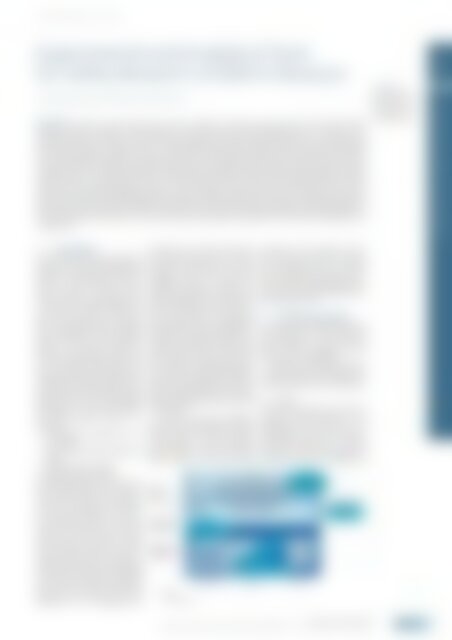atw 2018-04v6
You also want an ePaper? Increase the reach of your titles
YUMPU automatically turns print PDFs into web optimized ePapers that Google loves.
<strong>atw</strong> Vol. 63 (<strong>2018</strong>) | Issue 4 ı April<br />
Experimental and Analytical Tools<br />
for Safety Research of GEN IV Reactors<br />
G. Mazzini, M. Kyncl, Alis Musa and M. Ruscak<br />
Current research on nuclear safety in the world, in addition to supporting existing nuclear power plants (PLEX,<br />
mitigation of severe accidents, the development of accident tolerant fuel, decommissioning, etc.), is focused on the<br />
more detailed aspects of the new reactors. The new generation reactors are expected inter alia to use innovative types<br />
of fuel and new types of coolants, such as e.g. Super-Critical Water (SCW), supercritical CO 2 , liquid metals, fluoride<br />
salts or high-temperature Helium. The paper will describe new experimental infrastructure build recently in Research<br />
Centre Řež under the SUSEN (Sustainable Energy) project and available analytical tools for supporting safety research<br />
of GEN IV reactors. Two experimental loops - SCWL (Supercritical Water Loop) and HTHL (High Temperature Helium<br />
Loop) will serve as in-pile loops in the active core of the research reactor LVR-15. The loops insertion in the reactor<br />
LVR-15 requires performing additional safety analyses studying the mutual interference of the loops and the reactor,<br />
especially in conditions of abnormal operation or accident conditions of the loops. The paper will provide examples of<br />
these analyses made using codes ATHLET (supercritical water) and TRACE (high temperature He) illustrating process<br />
of their assessment and practical use. These activities provide significant opportunity for TSO team in building its new<br />
competencies.<br />
Revised version<br />
of a paper presented<br />
at the Eurosafe,<br />
Paris, France, 6 and<br />
7 November 2017.<br />
OPERATION AND NEW BUILD 221<br />
1 Introduction<br />
The Centrum Výzkumu Řež (CVŘ) and<br />
its partners in the Czech Republic and<br />
abroad are supporting the development<br />
[1] of the Generation IV and<br />
Fusion concepts as well as demonstrators<br />
of these technologies such<br />
as ALLEGRO, ALFRED, DEMO and<br />
others. For this reason, the CVŘ has<br />
had a large R&D program financed<br />
from SUStainable Energy (SUSEN)<br />
project and from its continuation<br />
Research 4 Sustenibility (R4S) [2].<br />
The construction and the operation of<br />
the new SUSEN infrastructure was<br />
supported by the grant of the Ministry<br />
of Education, Youth and Sports as the<br />
part of state help for the large research<br />
infrastructure in the Czech Republic<br />
dedicated to the period 2011–2019.<br />
The SUSEN project consists of 4<br />
programs:<br />
1. Technological Experimental Circuits<br />
(TEO)<br />
2. Structural and System Diagnostics<br />
(SSD)<br />
3. Nuclear Fuel Cycle (NFC)<br />
4. Material Research (MAT)<br />
Within this program, several facilities<br />
were designed and built in order to<br />
study and to address new challenges<br />
of such new technologies. In particular,<br />
the paper focuses on two new<br />
loops which are going to be inserted<br />
inside the LVR-15 research reactor<br />
existing in Řež. The LVR-15 is a light<br />
water tank-type research reactor in<br />
operation since 1957. It is placed in a<br />
stainless steel vessel under a shielding<br />
cover, has forced cooling, uses IRT-4M<br />
type fuel and an has an operational<br />
power level of 10 MWt. The reactor<br />
operations run in campaigns that<br />
usually last for 3 weeks, followed by<br />
an outage lasting for 10 to 14 days<br />
necessary for maintenance and fuel<br />
reloading. There can be also other<br />
campaigns which can operate for<br />
‘short-time’ experiments. Some of the<br />
LVR-15 applications are in the field of<br />
material irradiation research and services,<br />
neutron physics, development<br />
and production of new radiopharmaceuticals<br />
[3]. The loops in concern are<br />
the High Temperature Helium Loop<br />
(HTHL) and the Super Critical Water<br />
Loop (SCWL) and their main scope<br />
are to analyse the cladding behaviour<br />
and structural materials under different<br />
pressure, temperature and coolant<br />
media conditions different from the<br />
standard Light Water Reactors (LWR)<br />
technology [2].<br />
In order to get the regulatory<br />
permit for in-pile operation of these<br />
loops in LVR-15, CVŘ has to prepare<br />
an amendment to the Final Safety<br />
Analyses Report (FSAR) containing<br />
safety analyse of the loops under<br />
| | Fig. 1.<br />
CVR Facilities list.<br />
operational and accidental conditions.<br />
Aim of this paper is to present<br />
the methodology and the analyses<br />
done in support of this process, starting<br />
from code benchmarking/assessment<br />
and the methods adopted in preparing<br />
the safety case.<br />
2 Facilities description<br />
The map of experimental facilities put<br />
into operation in 2016 and those<br />
under preparation to be finalized in<br />
2017 is shown in Figure 1 in the<br />
technology – knowledge map.<br />
In particular, the SCWL and HTHL<br />
represent a pioneer and unique experimental<br />
facility for Gen. IV and Fusion.<br />
2.1 SCWL<br />
The SCWL is going to be a part of a<br />
research facility dedicated to GIV<br />
technologies which will focus on<br />
obtaining data in several areas of the<br />
supercritical fields like: corrosion<br />
processes of construction materials in<br />
supercritical water, with influence of<br />
Operation and New Build<br />
Experimental and Analytical Tools for Safety Research of GEN IV Reactors ı G. Mazzini, M. Kyncl, Alis Musa and M. Ruscak

















